Consumer Awareness, Knowledge, and Practices: Fresh Produce Report
VerifiedAdded on 2020/06/04
|115
|34814
|44
Report
AI Summary
This report presents a comprehensive analysis of consumer awareness, knowledge, and practices concerning fresh produce, encompassing both unpackaged and pre-packaged fruits and vegetables. The study delves into the importance of fresh produce in a healthy diet, highlighting its role in disease prevention and overall well-being. It explores the potential risks associated with foodborne illnesses linked to fresh produce, including contamination sources and contributing factors. The research investigates consumer behaviors, including purchasing habits, washing practices, and the impact of education on improving knowledge and safety measures. The report also examines government programs and the role of bacterial pathogens in foodborne illnesses, emphasizing the importance of hand hygiene and food safety guidelines. The findings aim to identify gaps in consumer awareness, propose strategies to mitigate foodborne illness risks, and provide insights for future research and policy development within the Australian context.
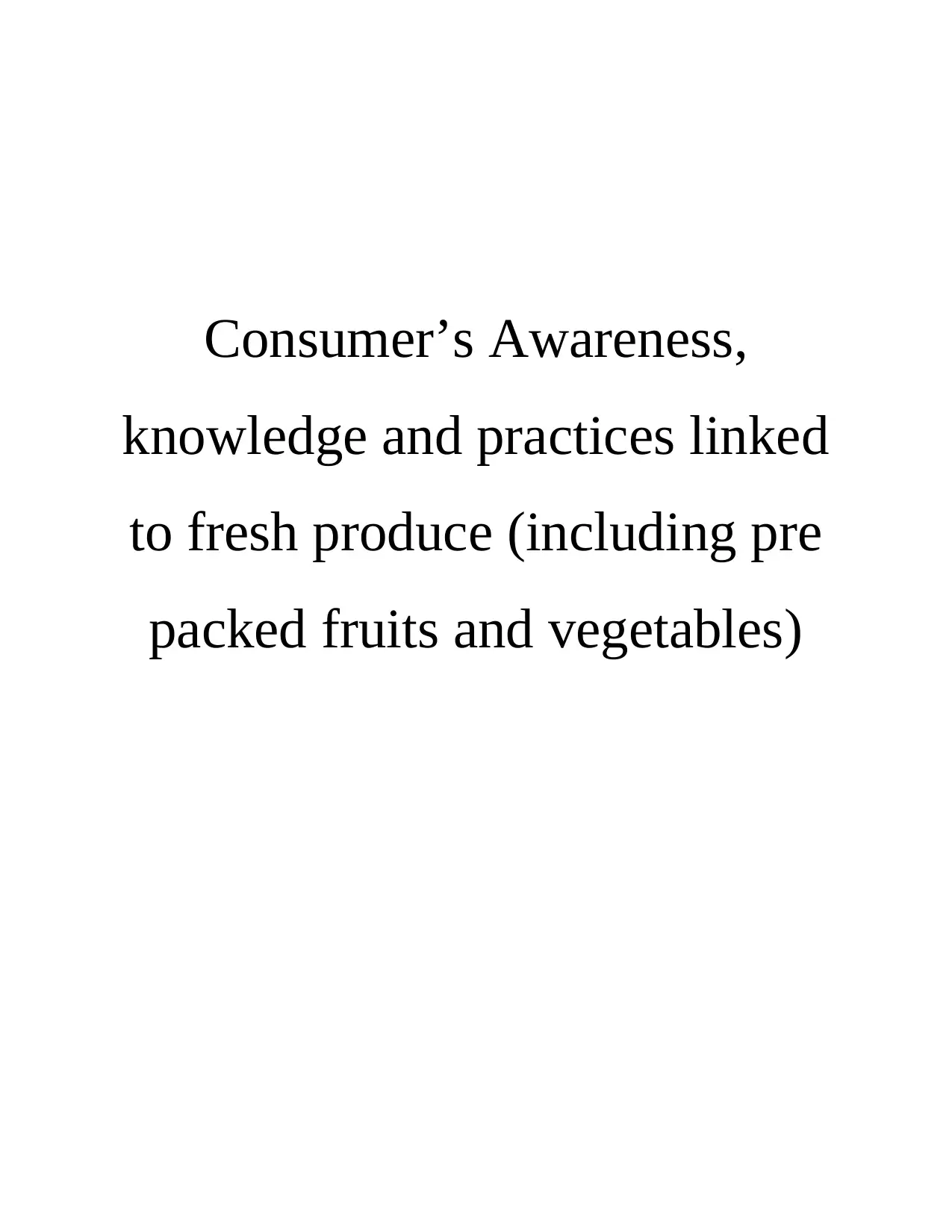
Consumer’s Awareness,
knowledge and practices linked
to fresh produce (including pre
packed fruits and vegetables)
knowledge and practices linked
to fresh produce (including pre
packed fruits and vegetables)
Paraphrase This Document
Need a fresh take? Get an instant paraphrase of this document with our AI Paraphraser
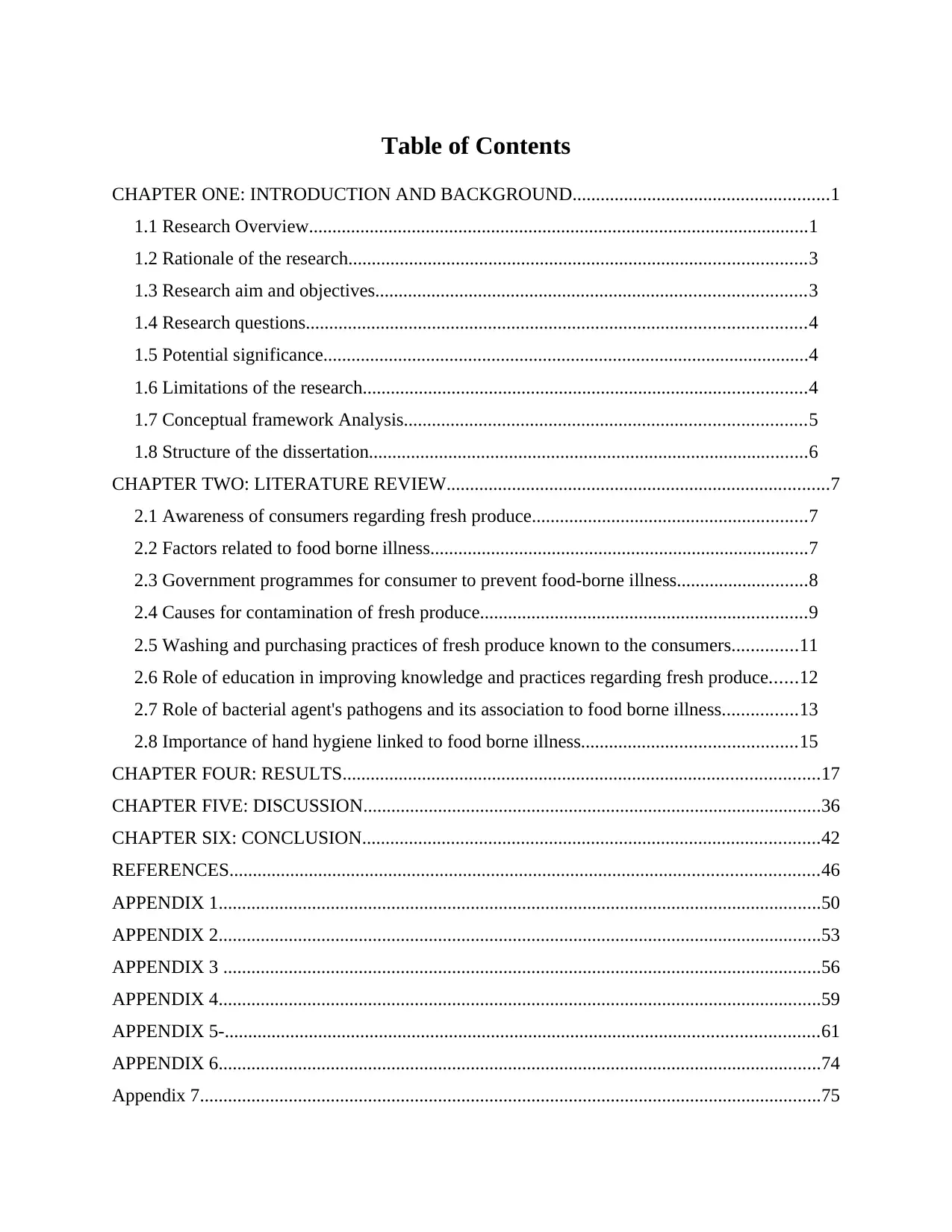
Table of Contents
CHAPTER ONE: INTRODUCTION AND BACKGROUND.......................................................1
1.1 Research Overview...........................................................................................................1
1.2 Rationale of the research..................................................................................................3
1.3 Research aim and objectives............................................................................................3
1.4 Research questions...........................................................................................................4
1.5 Potential significance........................................................................................................4
1.6 Limitations of the research...............................................................................................4
1.7 Conceptual framework Analysis......................................................................................5
1.8 Structure of the dissertation..............................................................................................6
CHAPTER TWO: LITERATURE REVIEW..................................................................................7
2.1 Awareness of consumers regarding fresh produce...........................................................7
2.2 Factors related to food borne illness.................................................................................7
2.3 Government programmes for consumer to prevent food-borne illness............................8
2.4 Causes for contamination of fresh produce......................................................................9
2.5 Washing and purchasing practices of fresh produce known to the consumers..............11
2.6 Role of education in improving knowledge and practices regarding fresh produce......12
2.7 Role of bacterial agent's pathogens and its association to food borne illness................13
2.8 Importance of hand hygiene linked to food borne illness..............................................15
CHAPTER FOUR: RESULTS......................................................................................................17
CHAPTER FIVE: DISCUSSION..................................................................................................36
CHAPTER SIX: CONCLUSION..................................................................................................42
REFERENCES..............................................................................................................................46
APPENDIX 1.................................................................................................................................50
APPENDIX 2.................................................................................................................................53
APPENDIX 3 ................................................................................................................................56
APPENDIX 4.................................................................................................................................59
APPENDIX 5-...............................................................................................................................61
APPENDIX 6.................................................................................................................................74
Appendix 7.....................................................................................................................................75
CHAPTER ONE: INTRODUCTION AND BACKGROUND.......................................................1
1.1 Research Overview...........................................................................................................1
1.2 Rationale of the research..................................................................................................3
1.3 Research aim and objectives............................................................................................3
1.4 Research questions...........................................................................................................4
1.5 Potential significance........................................................................................................4
1.6 Limitations of the research...............................................................................................4
1.7 Conceptual framework Analysis......................................................................................5
1.8 Structure of the dissertation..............................................................................................6
CHAPTER TWO: LITERATURE REVIEW..................................................................................7
2.1 Awareness of consumers regarding fresh produce...........................................................7
2.2 Factors related to food borne illness.................................................................................7
2.3 Government programmes for consumer to prevent food-borne illness............................8
2.4 Causes for contamination of fresh produce......................................................................9
2.5 Washing and purchasing practices of fresh produce known to the consumers..............11
2.6 Role of education in improving knowledge and practices regarding fresh produce......12
2.7 Role of bacterial agent's pathogens and its association to food borne illness................13
2.8 Importance of hand hygiene linked to food borne illness..............................................15
CHAPTER FOUR: RESULTS......................................................................................................17
CHAPTER FIVE: DISCUSSION..................................................................................................36
CHAPTER SIX: CONCLUSION..................................................................................................42
REFERENCES..............................................................................................................................46
APPENDIX 1.................................................................................................................................50
APPENDIX 2.................................................................................................................................53
APPENDIX 3 ................................................................................................................................56
APPENDIX 4.................................................................................................................................59
APPENDIX 5-...............................................................................................................................61
APPENDIX 6.................................................................................................................................74
Appendix 7.....................................................................................................................................75

APPENDIX 8 ................................................................................................................................76
APPENDIX 9 – .............................................................................................................................77
Appendix 10: .................................................................................................................................80
APPENDIX 11...............................................................................................................................82
APPENDIX 9 – .............................................................................................................................77
Appendix 10: .................................................................................................................................80
APPENDIX 11...............................................................................................................................82
⊘ This is a preview!⊘
Do you want full access?
Subscribe today to unlock all pages.

Trusted by 1+ million students worldwide
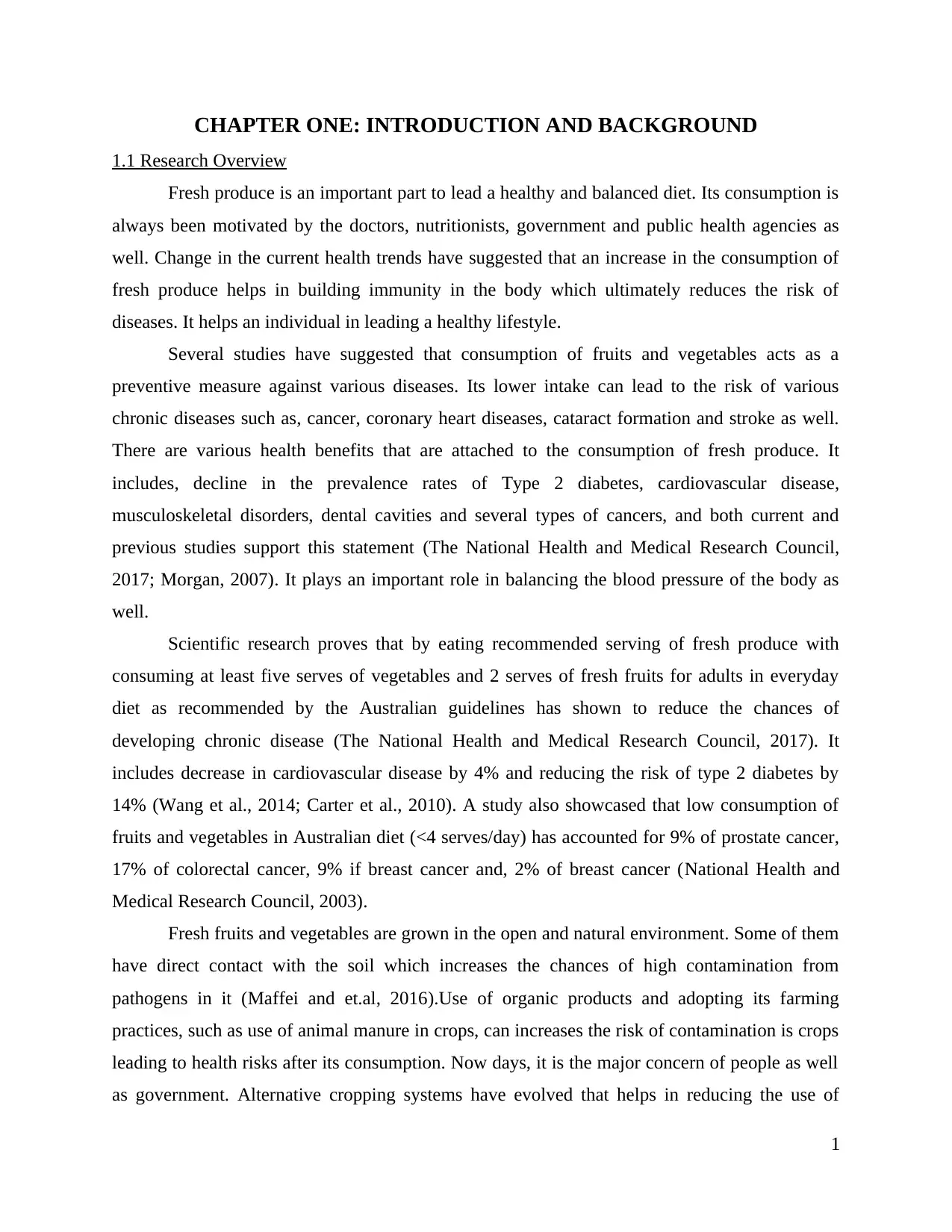
CHAPTER ONE: INTRODUCTION AND BACKGROUND
1.1 Research Overview
Fresh produce is an important part to lead a healthy and balanced diet. Its consumption is
always been motivated by the doctors, nutritionists, government and public health agencies as
well. Change in the current health trends have suggested that an increase in the consumption of
fresh produce helps in building immunity in the body which ultimately reduces the risk of
diseases. It helps an individual in leading a healthy lifestyle.
Several studies have suggested that consumption of fruits and vegetables acts as a
preventive measure against various diseases. Its lower intake can lead to the risk of various
chronic diseases such as, cancer, coronary heart diseases, cataract formation and stroke as well.
There are various health benefits that are attached to the consumption of fresh produce. It
includes, decline in the prevalence rates of Type 2 diabetes, cardiovascular disease,
musculoskeletal disorders, dental cavities and several types of cancers, and both current and
previous studies support this statement (The National Health and Medical Research Council,
2017; Morgan, 2007). It plays an important role in balancing the blood pressure of the body as
well.
Scientific research proves that by eating recommended serving of fresh produce with
consuming at least five serves of vegetables and 2 serves of fresh fruits for adults in everyday
diet as recommended by the Australian guidelines has shown to reduce the chances of
developing chronic disease (The National Health and Medical Research Council, 2017). It
includes decrease in cardiovascular disease by 4% and reducing the risk of type 2 diabetes by
14% (Wang et al., 2014; Carter et al., 2010). A study also showcased that low consumption of
fruits and vegetables in Australian diet (<4 serves/day) has accounted for 9% of prostate cancer,
17% of colorectal cancer, 9% if breast cancer and, 2% of breast cancer (National Health and
Medical Research Council, 2003).
Fresh fruits and vegetables are grown in the open and natural environment. Some of them
have direct contact with the soil which increases the chances of high contamination from
pathogens in it (Maffei and et.al, 2016).Use of organic products and adopting its farming
practices, such as use of animal manure in crops, can increases the risk of contamination is crops
leading to health risks after its consumption. Now days, it is the major concern of people as well
as government. Alternative cropping systems have evolved that helps in reducing the use of
1
1.1 Research Overview
Fresh produce is an important part to lead a healthy and balanced diet. Its consumption is
always been motivated by the doctors, nutritionists, government and public health agencies as
well. Change in the current health trends have suggested that an increase in the consumption of
fresh produce helps in building immunity in the body which ultimately reduces the risk of
diseases. It helps an individual in leading a healthy lifestyle.
Several studies have suggested that consumption of fruits and vegetables acts as a
preventive measure against various diseases. Its lower intake can lead to the risk of various
chronic diseases such as, cancer, coronary heart diseases, cataract formation and stroke as well.
There are various health benefits that are attached to the consumption of fresh produce. It
includes, decline in the prevalence rates of Type 2 diabetes, cardiovascular disease,
musculoskeletal disorders, dental cavities and several types of cancers, and both current and
previous studies support this statement (The National Health and Medical Research Council,
2017; Morgan, 2007). It plays an important role in balancing the blood pressure of the body as
well.
Scientific research proves that by eating recommended serving of fresh produce with
consuming at least five serves of vegetables and 2 serves of fresh fruits for adults in everyday
diet as recommended by the Australian guidelines has shown to reduce the chances of
developing chronic disease (The National Health and Medical Research Council, 2017). It
includes decrease in cardiovascular disease by 4% and reducing the risk of type 2 diabetes by
14% (Wang et al., 2014; Carter et al., 2010). A study also showcased that low consumption of
fruits and vegetables in Australian diet (<4 serves/day) has accounted for 9% of prostate cancer,
17% of colorectal cancer, 9% if breast cancer and, 2% of breast cancer (National Health and
Medical Research Council, 2003).
Fresh fruits and vegetables are grown in the open and natural environment. Some of them
have direct contact with the soil which increases the chances of high contamination from
pathogens in it (Maffei and et.al, 2016).Use of organic products and adopting its farming
practices, such as use of animal manure in crops, can increases the risk of contamination is crops
leading to health risks after its consumption. Now days, it is the major concern of people as well
as government. Alternative cropping systems have evolved that helps in reducing the use of
1
Paraphrase This Document
Need a fresh take? Get an instant paraphrase of this document with our AI Paraphraser
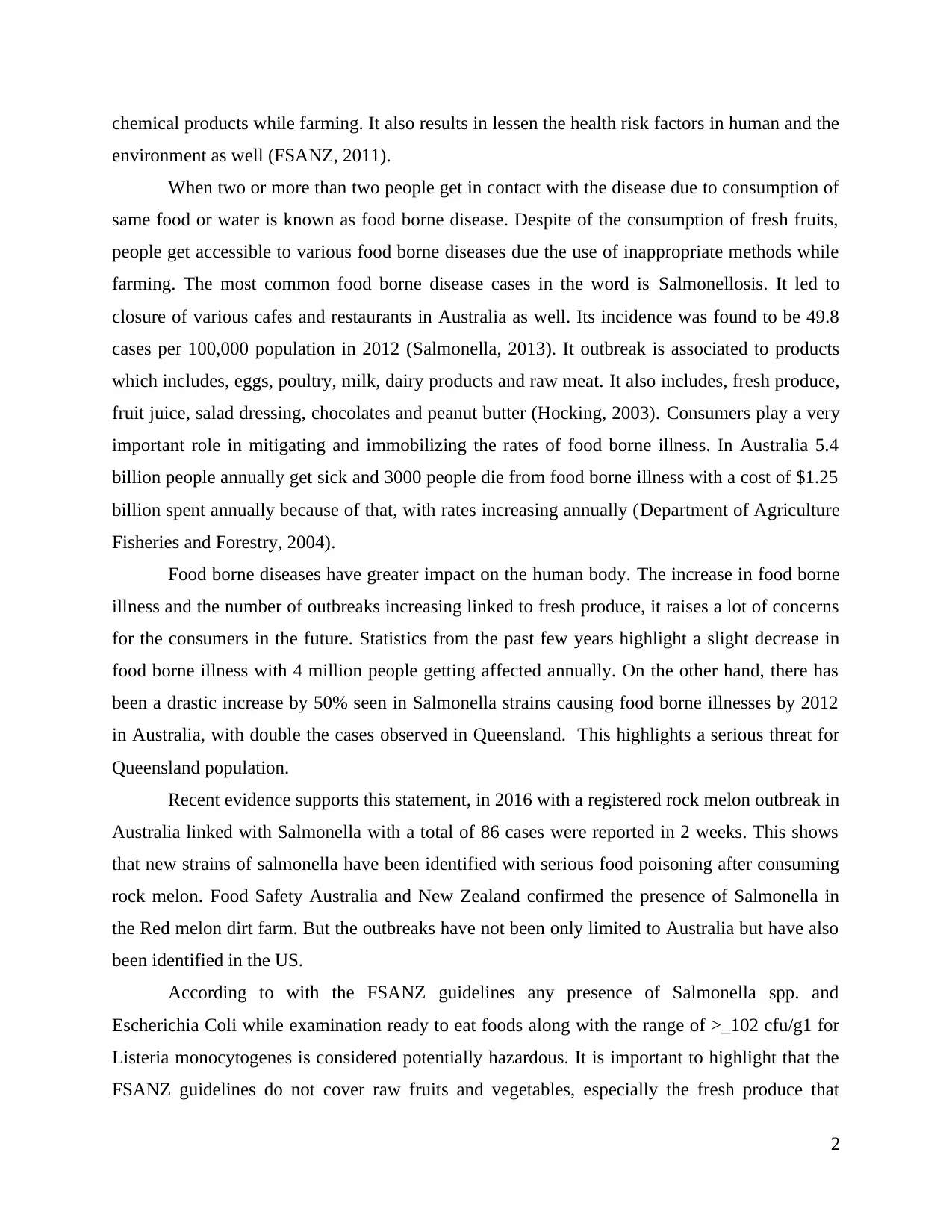
chemical products while farming. It also results in lessen the health risk factors in human and the
environment as well (FSANZ, 2011).
When two or more than two people get in contact with the disease due to consumption of
same food or water is known as food borne disease. Despite of the consumption of fresh fruits,
people get accessible to various food borne diseases due the use of inappropriate methods while
farming. The most common food borne disease cases in the word is Salmonellosis. It led to
closure of various cafes and restaurants in Australia as well. Its incidence was found to be 49.8
cases per 100,000 population in 2012 (Salmonella, 2013). It outbreak is associated to products
which includes, eggs, poultry, milk, dairy products and raw meat. It also includes, fresh produce,
fruit juice, salad dressing, chocolates and peanut butter (Hocking, 2003). Consumers play a very
important role in mitigating and immobilizing the rates of food borne illness. In Australia 5.4
billion people annually get sick and 3000 people die from food borne illness with a cost of $1.25
billion spent annually because of that, with rates increasing annually (Department of Agriculture
Fisheries and Forestry, 2004).
Food borne diseases have greater impact on the human body. The increase in food borne
illness and the number of outbreaks increasing linked to fresh produce, it raises a lot of concerns
for the consumers in the future. Statistics from the past few years highlight a slight decrease in
food borne illness with 4 million people getting affected annually. On the other hand, there has
been a drastic increase by 50% seen in Salmonella strains causing food borne illnesses by 2012
in Australia, with double the cases observed in Queensland. This highlights a serious threat for
Queensland population.
Recent evidence supports this statement, in 2016 with a registered rock melon outbreak in
Australia linked with Salmonella with a total of 86 cases were reported in 2 weeks. This shows
that new strains of salmonella have been identified with serious food poisoning after consuming
rock melon. Food Safety Australia and New Zealand confirmed the presence of Salmonella in
the Red melon dirt farm. But the outbreaks have not been only limited to Australia but have also
been identified in the US.
According to with the FSANZ guidelines any presence of Salmonella spp. and
Escherichia Coli while examination ready to eat foods along with the range of >_102 cfu/g1 for
Listeria monocytogenes is considered potentially hazardous. It is important to highlight that the
FSANZ guidelines do not cover raw fruits and vegetables, especially the fresh produce that
2
environment as well (FSANZ, 2011).
When two or more than two people get in contact with the disease due to consumption of
same food or water is known as food borne disease. Despite of the consumption of fresh fruits,
people get accessible to various food borne diseases due the use of inappropriate methods while
farming. The most common food borne disease cases in the word is Salmonellosis. It led to
closure of various cafes and restaurants in Australia as well. Its incidence was found to be 49.8
cases per 100,000 population in 2012 (Salmonella, 2013). It outbreak is associated to products
which includes, eggs, poultry, milk, dairy products and raw meat. It also includes, fresh produce,
fruit juice, salad dressing, chocolates and peanut butter (Hocking, 2003). Consumers play a very
important role in mitigating and immobilizing the rates of food borne illness. In Australia 5.4
billion people annually get sick and 3000 people die from food borne illness with a cost of $1.25
billion spent annually because of that, with rates increasing annually (Department of Agriculture
Fisheries and Forestry, 2004).
Food borne diseases have greater impact on the human body. The increase in food borne
illness and the number of outbreaks increasing linked to fresh produce, it raises a lot of concerns
for the consumers in the future. Statistics from the past few years highlight a slight decrease in
food borne illness with 4 million people getting affected annually. On the other hand, there has
been a drastic increase by 50% seen in Salmonella strains causing food borne illnesses by 2012
in Australia, with double the cases observed in Queensland. This highlights a serious threat for
Queensland population.
Recent evidence supports this statement, in 2016 with a registered rock melon outbreak in
Australia linked with Salmonella with a total of 86 cases were reported in 2 weeks. This shows
that new strains of salmonella have been identified with serious food poisoning after consuming
rock melon. Food Safety Australia and New Zealand confirmed the presence of Salmonella in
the Red melon dirt farm. But the outbreaks have not been only limited to Australia but have also
been identified in the US.
According to with the FSANZ guidelines any presence of Salmonella spp. and
Escherichia Coli while examination ready to eat foods along with the range of >_102 cfu/g1 for
Listeria monocytogenes is considered potentially hazardous. It is important to highlight that the
FSANZ guidelines do not cover raw fruits and vegetables, especially the fresh produce that
2
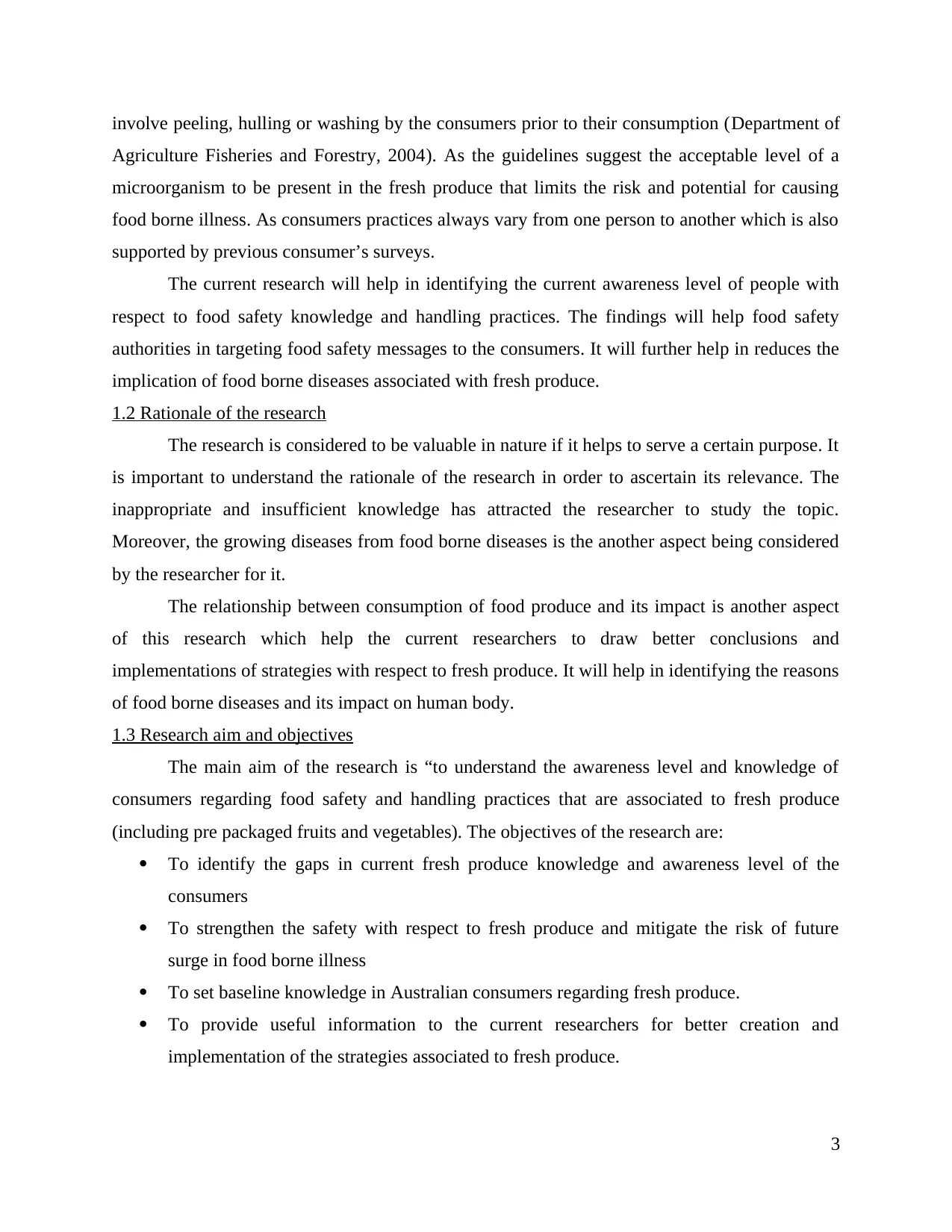
involve peeling, hulling or washing by the consumers prior to their consumption (Department of
Agriculture Fisheries and Forestry, 2004). As the guidelines suggest the acceptable level of a
microorganism to be present in the fresh produce that limits the risk and potential for causing
food borne illness. As consumers practices always vary from one person to another which is also
supported by previous consumer’s surveys.
The current research will help in identifying the current awareness level of people with
respect to food safety knowledge and handling practices. The findings will help food safety
authorities in targeting food safety messages to the consumers. It will further help in reduces the
implication of food borne diseases associated with fresh produce.
1.2 Rationale of the research
The research is considered to be valuable in nature if it helps to serve a certain purpose. It
is important to understand the rationale of the research in order to ascertain its relevance. The
inappropriate and insufficient knowledge has attracted the researcher to study the topic.
Moreover, the growing diseases from food borne diseases is the another aspect being considered
by the researcher for it.
The relationship between consumption of food produce and its impact is another aspect
of this research which help the current researchers to draw better conclusions and
implementations of strategies with respect to fresh produce. It will help in identifying the reasons
of food borne diseases and its impact on human body.
1.3 Research aim and objectives
The main aim of the research is “to understand the awareness level and knowledge of
consumers regarding food safety and handling practices that are associated to fresh produce
(including pre packaged fruits and vegetables). The objectives of the research are:
To identify the gaps in current fresh produce knowledge and awareness level of the
consumers
To strengthen the safety with respect to fresh produce and mitigate the risk of future
surge in food borne illness
To set baseline knowledge in Australian consumers regarding fresh produce.
To provide useful information to the current researchers for better creation and
implementation of the strategies associated to fresh produce.
3
Agriculture Fisheries and Forestry, 2004). As the guidelines suggest the acceptable level of a
microorganism to be present in the fresh produce that limits the risk and potential for causing
food borne illness. As consumers practices always vary from one person to another which is also
supported by previous consumer’s surveys.
The current research will help in identifying the current awareness level of people with
respect to food safety knowledge and handling practices. The findings will help food safety
authorities in targeting food safety messages to the consumers. It will further help in reduces the
implication of food borne diseases associated with fresh produce.
1.2 Rationale of the research
The research is considered to be valuable in nature if it helps to serve a certain purpose. It
is important to understand the rationale of the research in order to ascertain its relevance. The
inappropriate and insufficient knowledge has attracted the researcher to study the topic.
Moreover, the growing diseases from food borne diseases is the another aspect being considered
by the researcher for it.
The relationship between consumption of food produce and its impact is another aspect
of this research which help the current researchers to draw better conclusions and
implementations of strategies with respect to fresh produce. It will help in identifying the reasons
of food borne diseases and its impact on human body.
1.3 Research aim and objectives
The main aim of the research is “to understand the awareness level and knowledge of
consumers regarding food safety and handling practices that are associated to fresh produce
(including pre packaged fruits and vegetables). The objectives of the research are:
To identify the gaps in current fresh produce knowledge and awareness level of the
consumers
To strengthen the safety with respect to fresh produce and mitigate the risk of future
surge in food borne illness
To set baseline knowledge in Australian consumers regarding fresh produce.
To provide useful information to the current researchers for better creation and
implementation of the strategies associated to fresh produce.
3
⊘ This is a preview!⊘
Do you want full access?
Subscribe today to unlock all pages.

Trusted by 1+ million students worldwide
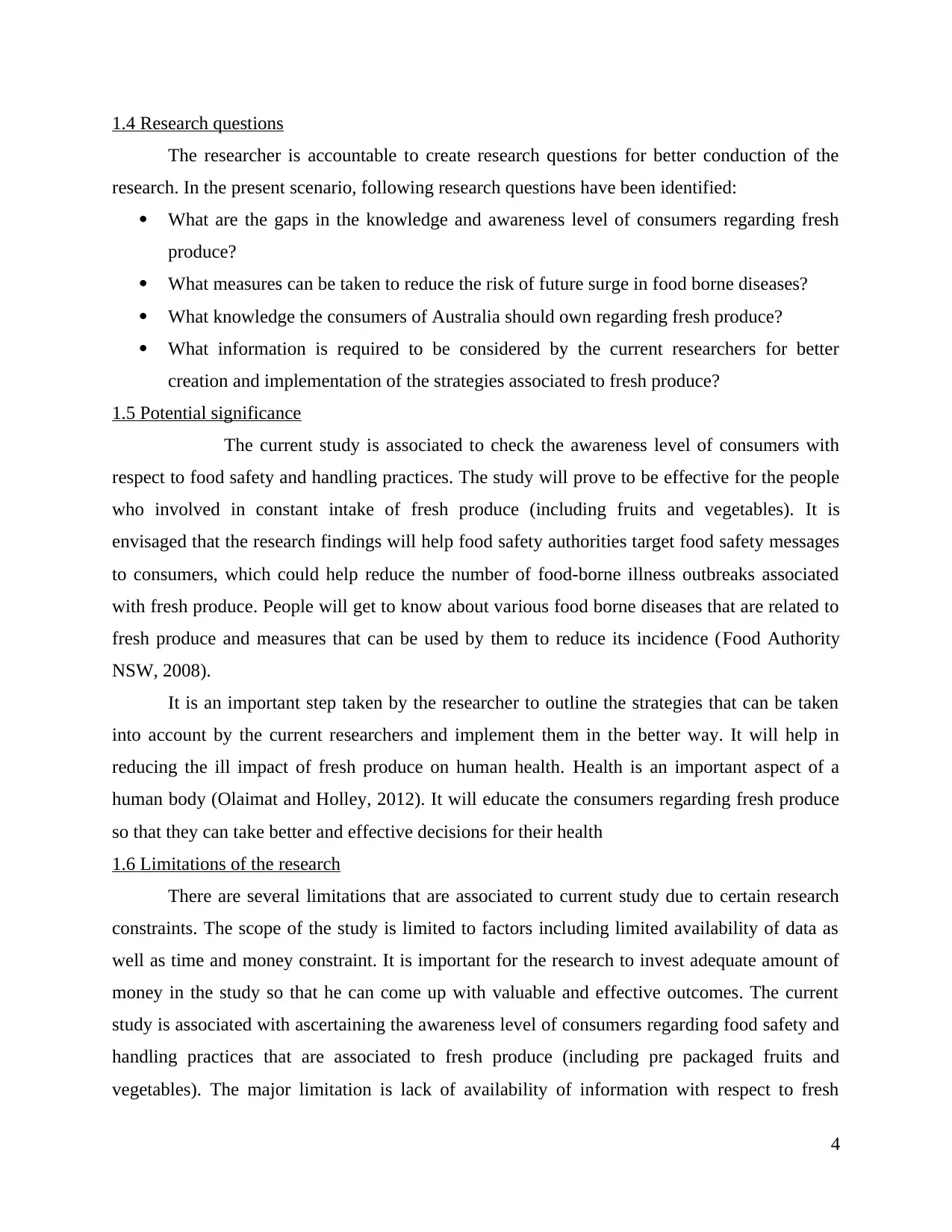
1.4 Research questions
The researcher is accountable to create research questions for better conduction of the
research. In the present scenario, following research questions have been identified:
What are the gaps in the knowledge and awareness level of consumers regarding fresh
produce?
What measures can be taken to reduce the risk of future surge in food borne diseases?
What knowledge the consumers of Australia should own regarding fresh produce?
What information is required to be considered by the current researchers for better
creation and implementation of the strategies associated to fresh produce?
1.5 Potential significance
The current study is associated to check the awareness level of consumers with
respect to food safety and handling practices. The study will prove to be effective for the people
who involved in constant intake of fresh produce (including fruits and vegetables). It is
envisaged that the research findings will help food safety authorities target food safety messages
to consumers, which could help reduce the number of food-borne illness outbreaks associated
with fresh produce. People will get to know about various food borne diseases that are related to
fresh produce and measures that can be used by them to reduce its incidence (Food Authority
NSW, 2008).
It is an important step taken by the researcher to outline the strategies that can be taken
into account by the current researchers and implement them in the better way. It will help in
reducing the ill impact of fresh produce on human health. Health is an important aspect of a
human body (Olaimat and Holley, 2012). It will educate the consumers regarding fresh produce
so that they can take better and effective decisions for their health
1.6 Limitations of the research
There are several limitations that are associated to current study due to certain research
constraints. The scope of the study is limited to factors including limited availability of data as
well as time and money constraint. It is important for the research to invest adequate amount of
money in the study so that he can come up with valuable and effective outcomes. The current
study is associated with ascertaining the awareness level of consumers regarding food safety and
handling practices that are associated to fresh produce (including pre packaged fruits and
vegetables). The major limitation is lack of availability of information with respect to fresh
4
The researcher is accountable to create research questions for better conduction of the
research. In the present scenario, following research questions have been identified:
What are the gaps in the knowledge and awareness level of consumers regarding fresh
produce?
What measures can be taken to reduce the risk of future surge in food borne diseases?
What knowledge the consumers of Australia should own regarding fresh produce?
What information is required to be considered by the current researchers for better
creation and implementation of the strategies associated to fresh produce?
1.5 Potential significance
The current study is associated to check the awareness level of consumers with
respect to food safety and handling practices. The study will prove to be effective for the people
who involved in constant intake of fresh produce (including fruits and vegetables). It is
envisaged that the research findings will help food safety authorities target food safety messages
to consumers, which could help reduce the number of food-borne illness outbreaks associated
with fresh produce. People will get to know about various food borne diseases that are related to
fresh produce and measures that can be used by them to reduce its incidence (Food Authority
NSW, 2008).
It is an important step taken by the researcher to outline the strategies that can be taken
into account by the current researchers and implement them in the better way. It will help in
reducing the ill impact of fresh produce on human health. Health is an important aspect of a
human body (Olaimat and Holley, 2012). It will educate the consumers regarding fresh produce
so that they can take better and effective decisions for their health
1.6 Limitations of the research
There are several limitations that are associated to current study due to certain research
constraints. The scope of the study is limited to factors including limited availability of data as
well as time and money constraint. It is important for the research to invest adequate amount of
money in the study so that he can come up with valuable and effective outcomes. The current
study is associated with ascertaining the awareness level of consumers regarding food safety and
handling practices that are associated to fresh produce (including pre packaged fruits and
vegetables). The major limitation is lack of availability of information with respect to fresh
4
Paraphrase This Document
Need a fresh take? Get an instant paraphrase of this document with our AI Paraphraser
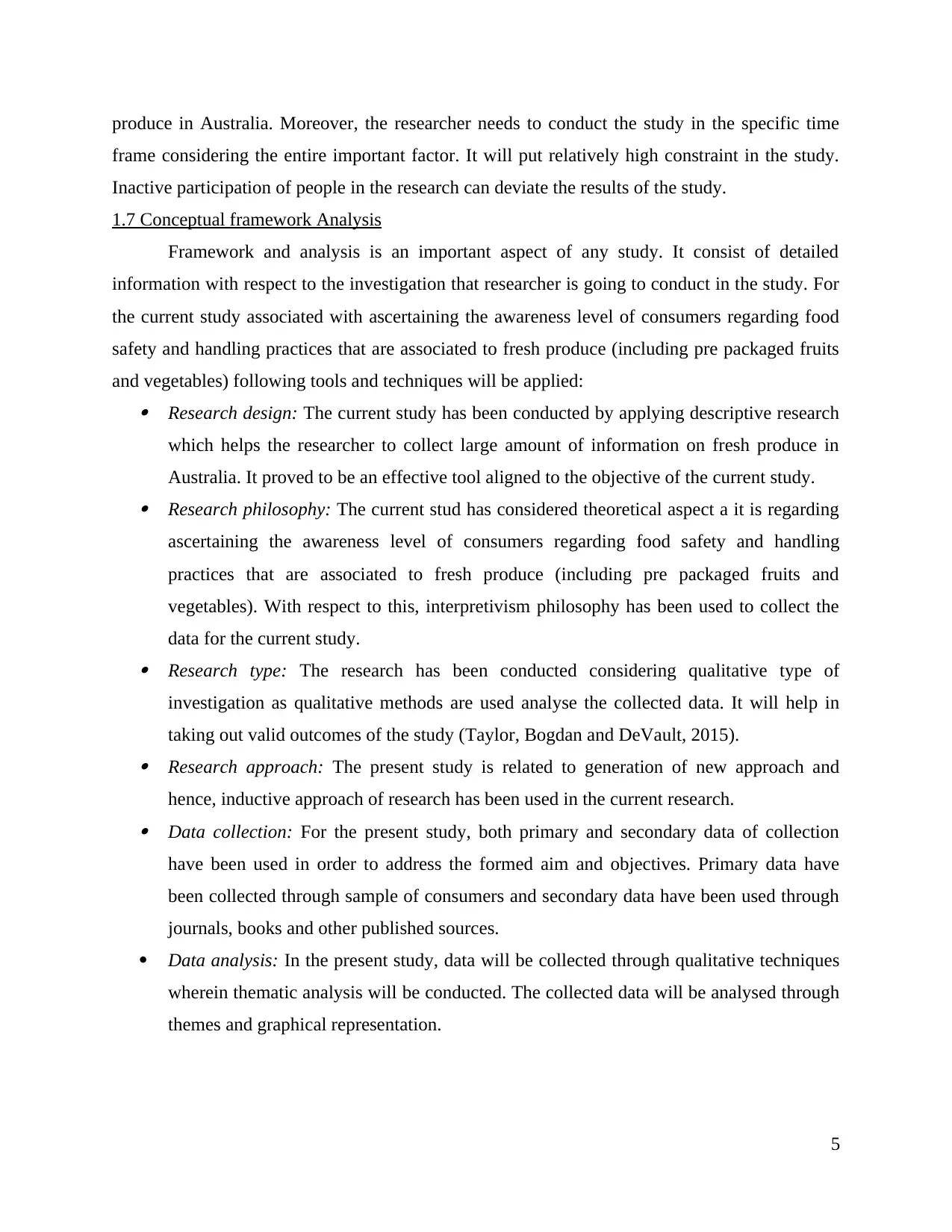
produce in Australia. Moreover, the researcher needs to conduct the study in the specific time
frame considering the entire important factor. It will put relatively high constraint in the study.
Inactive participation of people in the research can deviate the results of the study.
1.7 Conceptual framework Analysis
Framework and analysis is an important aspect of any study. It consist of detailed
information with respect to the investigation that researcher is going to conduct in the study. For
the current study associated with ascertaining the awareness level of consumers regarding food
safety and handling practices that are associated to fresh produce (including pre packaged fruits
and vegetables) following tools and techniques will be applied: Research design: The current study has been conducted by applying descriptive research
which helps the researcher to collect large amount of information on fresh produce in
Australia. It proved to be an effective tool aligned to the objective of the current study. Research philosophy: The current stud has considered theoretical aspect a it is regarding
ascertaining the awareness level of consumers regarding food safety and handling
practices that are associated to fresh produce (including pre packaged fruits and
vegetables). With respect to this, interpretivism philosophy has been used to collect the
data for the current study. Research type: The research has been conducted considering qualitative type of
investigation as qualitative methods are used analyse the collected data. It will help in
taking out valid outcomes of the study (Taylor, Bogdan and DeVault, 2015). Research approach: The present study is related to generation of new approach and
hence, inductive approach of research has been used in the current research. Data collection: For the present study, both primary and secondary data of collection
have been used in order to address the formed aim and objectives. Primary data have
been collected through sample of consumers and secondary data have been used through
journals, books and other published sources.
Data analysis: In the present study, data will be collected through qualitative techniques
wherein thematic analysis will be conducted. The collected data will be analysed through
themes and graphical representation.
5
frame considering the entire important factor. It will put relatively high constraint in the study.
Inactive participation of people in the research can deviate the results of the study.
1.7 Conceptual framework Analysis
Framework and analysis is an important aspect of any study. It consist of detailed
information with respect to the investigation that researcher is going to conduct in the study. For
the current study associated with ascertaining the awareness level of consumers regarding food
safety and handling practices that are associated to fresh produce (including pre packaged fruits
and vegetables) following tools and techniques will be applied: Research design: The current study has been conducted by applying descriptive research
which helps the researcher to collect large amount of information on fresh produce in
Australia. It proved to be an effective tool aligned to the objective of the current study. Research philosophy: The current stud has considered theoretical aspect a it is regarding
ascertaining the awareness level of consumers regarding food safety and handling
practices that are associated to fresh produce (including pre packaged fruits and
vegetables). With respect to this, interpretivism philosophy has been used to collect the
data for the current study. Research type: The research has been conducted considering qualitative type of
investigation as qualitative methods are used analyse the collected data. It will help in
taking out valid outcomes of the study (Taylor, Bogdan and DeVault, 2015). Research approach: The present study is related to generation of new approach and
hence, inductive approach of research has been used in the current research. Data collection: For the present study, both primary and secondary data of collection
have been used in order to address the formed aim and objectives. Primary data have
been collected through sample of consumers and secondary data have been used through
journals, books and other published sources.
Data analysis: In the present study, data will be collected through qualitative techniques
wherein thematic analysis will be conducted. The collected data will be analysed through
themes and graphical representation.
5
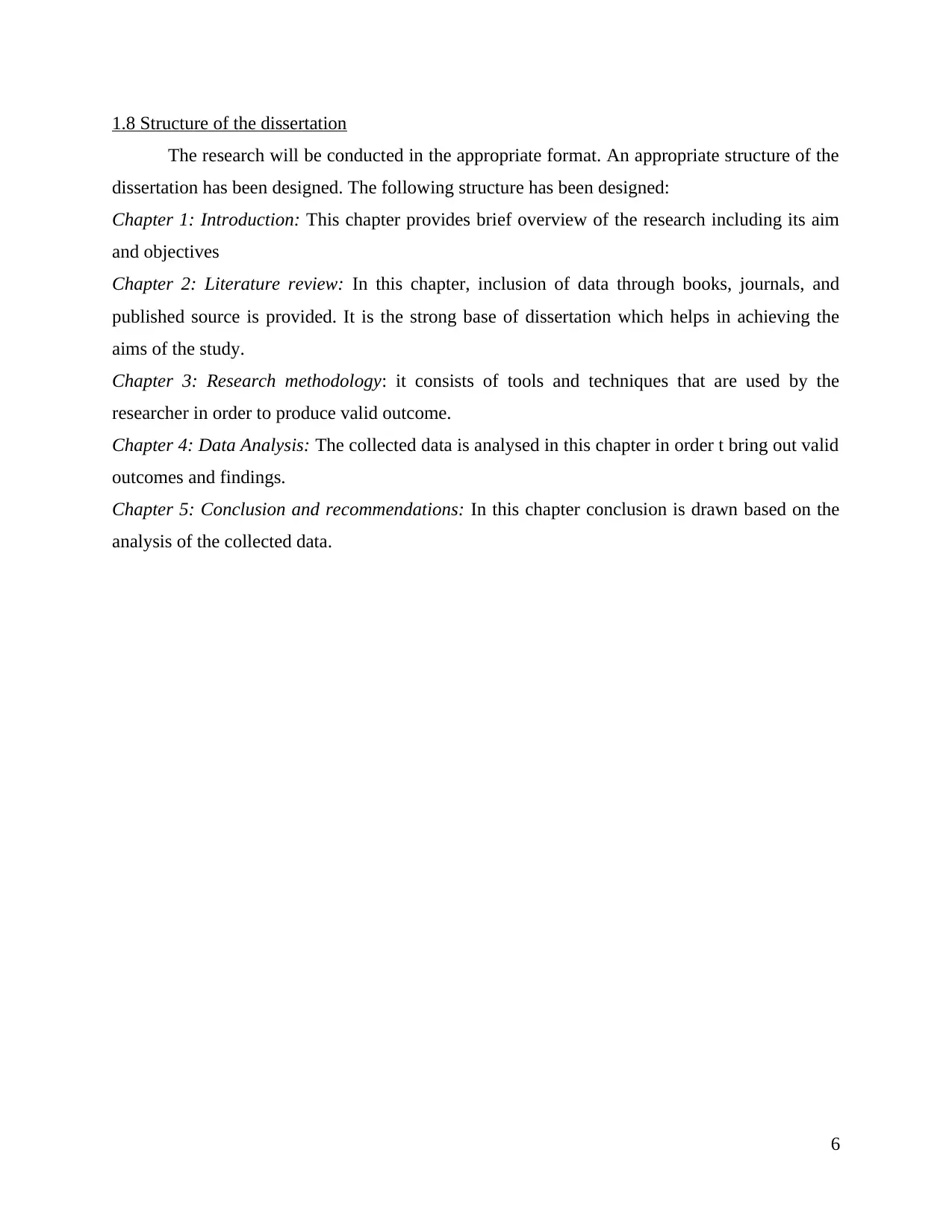
1.8 Structure of the dissertation
The research will be conducted in the appropriate format. An appropriate structure of the
dissertation has been designed. The following structure has been designed:
Chapter 1: Introduction: This chapter provides brief overview of the research including its aim
and objectives
Chapter 2: Literature review: In this chapter, inclusion of data through books, journals, and
published source is provided. It is the strong base of dissertation which helps in achieving the
aims of the study.
Chapter 3: Research methodology: it consists of tools and techniques that are used by the
researcher in order to produce valid outcome.
Chapter 4: Data Analysis: The collected data is analysed in this chapter in order t bring out valid
outcomes and findings.
Chapter 5: Conclusion and recommendations: In this chapter conclusion is drawn based on the
analysis of the collected data.
6
The research will be conducted in the appropriate format. An appropriate structure of the
dissertation has been designed. The following structure has been designed:
Chapter 1: Introduction: This chapter provides brief overview of the research including its aim
and objectives
Chapter 2: Literature review: In this chapter, inclusion of data through books, journals, and
published source is provided. It is the strong base of dissertation which helps in achieving the
aims of the study.
Chapter 3: Research methodology: it consists of tools and techniques that are used by the
researcher in order to produce valid outcome.
Chapter 4: Data Analysis: The collected data is analysed in this chapter in order t bring out valid
outcomes and findings.
Chapter 5: Conclusion and recommendations: In this chapter conclusion is drawn based on the
analysis of the collected data.
6
⊘ This is a preview!⊘
Do you want full access?
Subscribe today to unlock all pages.

Trusted by 1+ million students worldwide
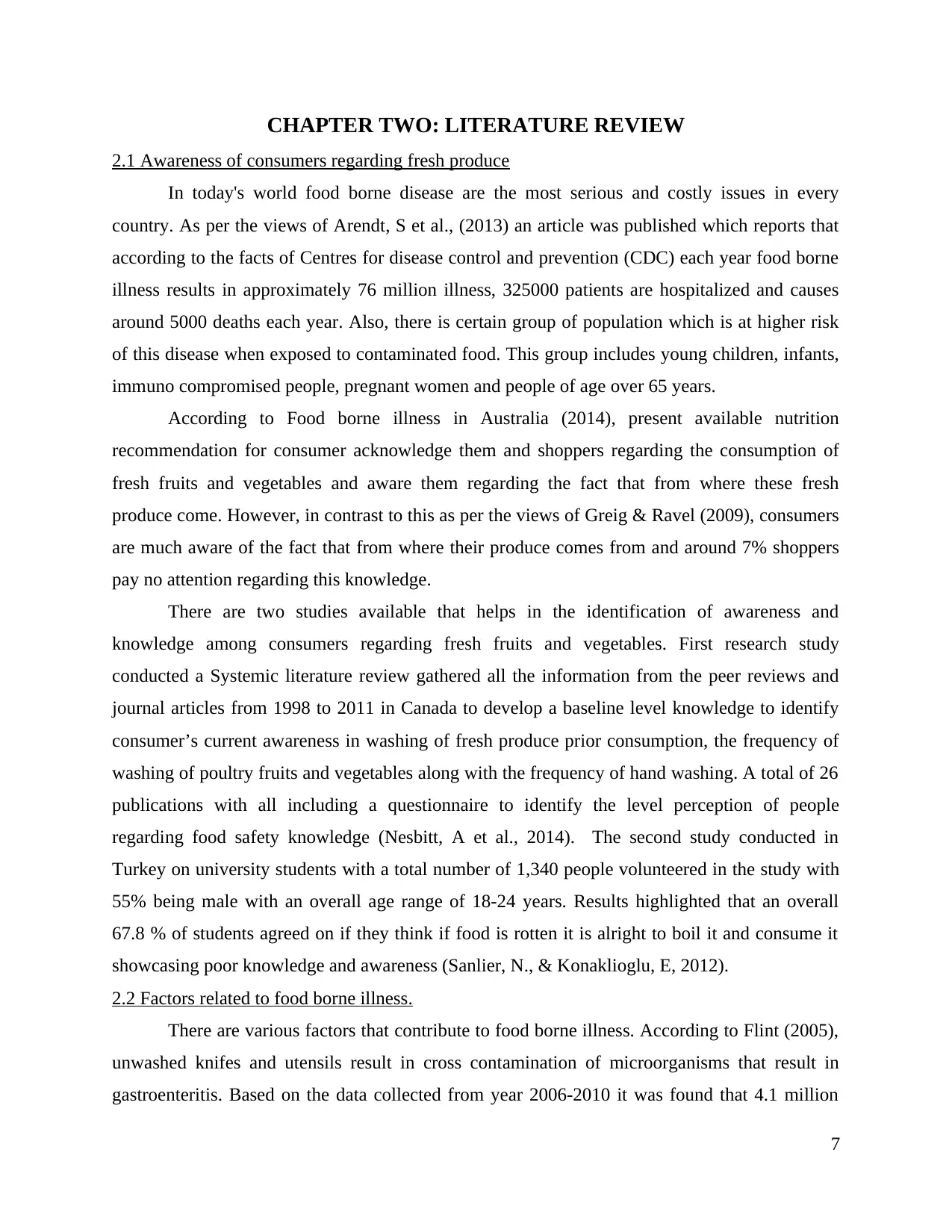
CHAPTER TWO: LITERATURE REVIEW
2.1 Awareness of consumers regarding fresh produce
In today's world food borne disease are the most serious and costly issues in every
country. As per the views of Arendt, S et al., (2013) an article was published which reports that
according to the facts of Centres for disease control and prevention (CDC) each year food borne
illness results in approximately 76 million illness, 325000 patients are hospitalized and causes
around 5000 deaths each year. Also, there is certain group of population which is at higher risk
of this disease when exposed to contaminated food. This group includes young children, infants,
immuno compromised people, pregnant women and people of age over 65 years.
According to Food borne illness in Australia (2014), present available nutrition
recommendation for consumer acknowledge them and shoppers regarding the consumption of
fresh fruits and vegetables and aware them regarding the fact that from where these fresh
produce come. However, in contrast to this as per the views of Greig & Ravel (2009), consumers
are much aware of the fact that from where their produce comes from and around 7% shoppers
pay no attention regarding this knowledge.
There are two studies available that helps in the identification of awareness and
knowledge among consumers regarding fresh fruits and vegetables. First research study
conducted a Systemic literature review gathered all the information from the peer reviews and
journal articles from 1998 to 2011 in Canada to develop a baseline level knowledge to identify
consumer’s current awareness in washing of fresh produce prior consumption, the frequency of
washing of poultry fruits and vegetables along with the frequency of hand washing. A total of 26
publications with all including a questionnaire to identify the level perception of people
regarding food safety knowledge (Nesbitt, A et al., 2014). The second study conducted in
Turkey on university students with a total number of 1,340 people volunteered in the study with
55% being male with an overall age range of 18-24 years. Results highlighted that an overall
67.8 % of students agreed on if they think if food is rotten it is alright to boil it and consume it
showcasing poor knowledge and awareness (Sanlier, N., & Konaklioglu, E, 2012).
2.2 Factors related to food borne illness.
There are various factors that contribute to food borne illness. According to Flint (2005),
unwashed knifes and utensils result in cross contamination of microorganisms that result in
gastroenteritis. Based on the data collected from year 2006-2010 it was found that 4.1 million
7
2.1 Awareness of consumers regarding fresh produce
In today's world food borne disease are the most serious and costly issues in every
country. As per the views of Arendt, S et al., (2013) an article was published which reports that
according to the facts of Centres for disease control and prevention (CDC) each year food borne
illness results in approximately 76 million illness, 325000 patients are hospitalized and causes
around 5000 deaths each year. Also, there is certain group of population which is at higher risk
of this disease when exposed to contaminated food. This group includes young children, infants,
immuno compromised people, pregnant women and people of age over 65 years.
According to Food borne illness in Australia (2014), present available nutrition
recommendation for consumer acknowledge them and shoppers regarding the consumption of
fresh fruits and vegetables and aware them regarding the fact that from where these fresh
produce come. However, in contrast to this as per the views of Greig & Ravel (2009), consumers
are much aware of the fact that from where their produce comes from and around 7% shoppers
pay no attention regarding this knowledge.
There are two studies available that helps in the identification of awareness and
knowledge among consumers regarding fresh fruits and vegetables. First research study
conducted a Systemic literature review gathered all the information from the peer reviews and
journal articles from 1998 to 2011 in Canada to develop a baseline level knowledge to identify
consumer’s current awareness in washing of fresh produce prior consumption, the frequency of
washing of poultry fruits and vegetables along with the frequency of hand washing. A total of 26
publications with all including a questionnaire to identify the level perception of people
regarding food safety knowledge (Nesbitt, A et al., 2014). The second study conducted in
Turkey on university students with a total number of 1,340 people volunteered in the study with
55% being male with an overall age range of 18-24 years. Results highlighted that an overall
67.8 % of students agreed on if they think if food is rotten it is alright to boil it and consume it
showcasing poor knowledge and awareness (Sanlier, N., & Konaklioglu, E, 2012).
2.2 Factors related to food borne illness.
There are various factors that contribute to food borne illness. According to Flint (2005),
unwashed knifes and utensils result in cross contamination of microorganisms that result in
gastroenteritis. Based on the data collected from year 2006-2010 it was found that 4.1 million
7
Paraphrase This Document
Need a fresh take? Get an instant paraphrase of this document with our AI Paraphraser
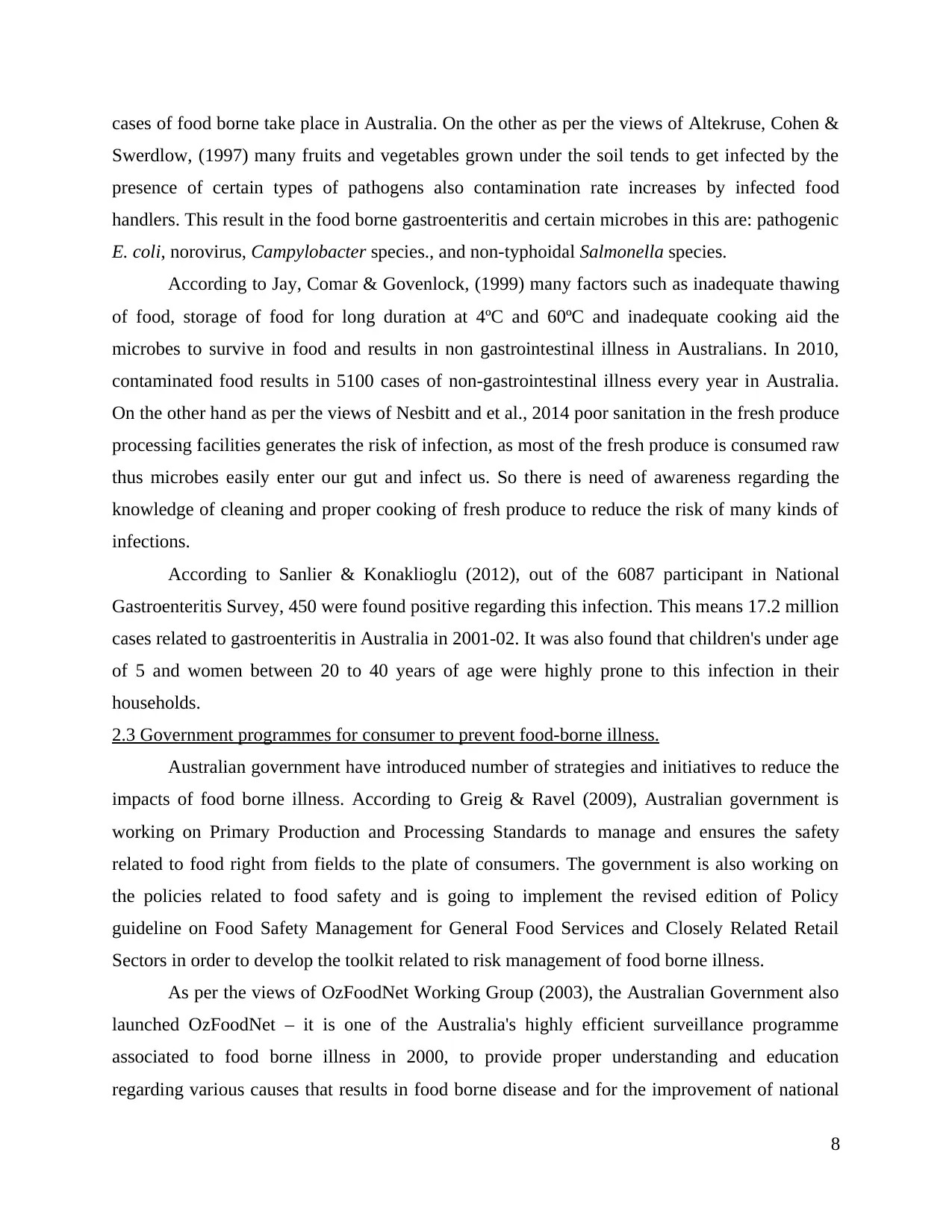
cases of food borne take place in Australia. On the other as per the views of Altekruse, Cohen &
Swerdlow, (1997) many fruits and vegetables grown under the soil tends to get infected by the
presence of certain types of pathogens also contamination rate increases by infected food
handlers. This result in the food borne gastroenteritis and certain microbes in this are: pathogenic
E. coli, norovirus, Campylobacter species., and non-typhoidal Salmonella species.
According to Jay, Comar & Govenlock, (1999) many factors such as inadequate thawing
of food, storage of food for long duration at 4ºC and 60ºC and inadequate cooking aid the
microbes to survive in food and results in non gastrointestinal illness in Australians. In 2010,
contaminated food results in 5100 cases of non-gastrointestinal illness every year in Australia.
On the other hand as per the views of Nesbitt and et al., 2014 poor sanitation in the fresh produce
processing facilities generates the risk of infection, as most of the fresh produce is consumed raw
thus microbes easily enter our gut and infect us. So there is need of awareness regarding the
knowledge of cleaning and proper cooking of fresh produce to reduce the risk of many kinds of
infections.
According to Sanlier & Konaklioglu (2012), out of the 6087 participant in National
Gastroenteritis Survey, 450 were found positive regarding this infection. This means 17.2 million
cases related to gastroenteritis in Australia in 2001-02. It was also found that children's under age
of 5 and women between 20 to 40 years of age were highly prone to this infection in their
households.
2.3 Government programmes for consumer to prevent food-borne illness.
Australian government have introduced number of strategies and initiatives to reduce the
impacts of food borne illness. According to Greig & Ravel (2009), Australian government is
working on Primary Production and Processing Standards to manage and ensures the safety
related to food right from fields to the plate of consumers. The government is also working on
the policies related to food safety and is going to implement the revised edition of Policy
guideline on Food Safety Management for General Food Services and Closely Related Retail
Sectors in order to develop the toolkit related to risk management of food borne illness.
As per the views of OzFoodNet Working Group (2003), the Australian Government also
launched OzFoodNet – it is one of the Australia's highly efficient surveillance programme
associated to food borne illness in 2000, to provide proper understanding and education
regarding various causes that results in food borne disease and for the improvement of national
8
Swerdlow, (1997) many fruits and vegetables grown under the soil tends to get infected by the
presence of certain types of pathogens also contamination rate increases by infected food
handlers. This result in the food borne gastroenteritis and certain microbes in this are: pathogenic
E. coli, norovirus, Campylobacter species., and non-typhoidal Salmonella species.
According to Jay, Comar & Govenlock, (1999) many factors such as inadequate thawing
of food, storage of food for long duration at 4ºC and 60ºC and inadequate cooking aid the
microbes to survive in food and results in non gastrointestinal illness in Australians. In 2010,
contaminated food results in 5100 cases of non-gastrointestinal illness every year in Australia.
On the other hand as per the views of Nesbitt and et al., 2014 poor sanitation in the fresh produce
processing facilities generates the risk of infection, as most of the fresh produce is consumed raw
thus microbes easily enter our gut and infect us. So there is need of awareness regarding the
knowledge of cleaning and proper cooking of fresh produce to reduce the risk of many kinds of
infections.
According to Sanlier & Konaklioglu (2012), out of the 6087 participant in National
Gastroenteritis Survey, 450 were found positive regarding this infection. This means 17.2 million
cases related to gastroenteritis in Australia in 2001-02. It was also found that children's under age
of 5 and women between 20 to 40 years of age were highly prone to this infection in their
households.
2.3 Government programmes for consumer to prevent food-borne illness.
Australian government have introduced number of strategies and initiatives to reduce the
impacts of food borne illness. According to Greig & Ravel (2009), Australian government is
working on Primary Production and Processing Standards to manage and ensures the safety
related to food right from fields to the plate of consumers. The government is also working on
the policies related to food safety and is going to implement the revised edition of Policy
guideline on Food Safety Management for General Food Services and Closely Related Retail
Sectors in order to develop the toolkit related to risk management of food borne illness.
As per the views of OzFoodNet Working Group (2003), the Australian Government also
launched OzFoodNet – it is one of the Australia's highly efficient surveillance programme
associated to food borne illness in 2000, to provide proper understanding and education
regarding various causes that results in food borne disease and for the improvement of national
8
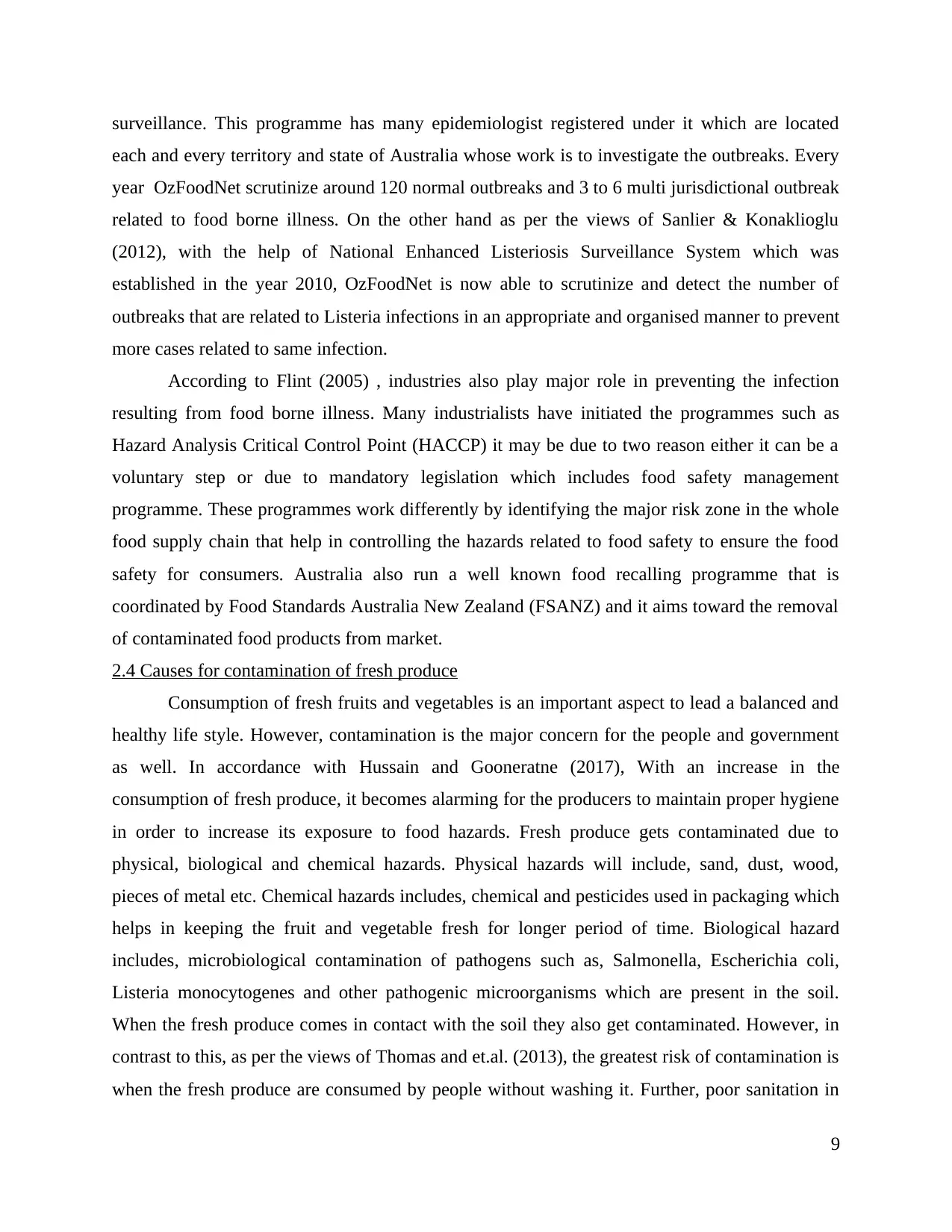
surveillance. This programme has many epidemiologist registered under it which are located
each and every territory and state of Australia whose work is to investigate the outbreaks. Every
year OzFoodNet scrutinize around 120 normal outbreaks and 3 to 6 multi jurisdictional outbreak
related to food borne illness. On the other hand as per the views of Sanlier & Konaklioglu
(2012), with the help of National Enhanced Listeriosis Surveillance System which was
established in the year 2010, OzFoodNet is now able to scrutinize and detect the number of
outbreaks that are related to Listeria infections in an appropriate and organised manner to prevent
more cases related to same infection.
According to Flint (2005) , industries also play major role in preventing the infection
resulting from food borne illness. Many industrialists have initiated the programmes such as
Hazard Analysis Critical Control Point (HACCP) it may be due to two reason either it can be a
voluntary step or due to mandatory legislation which includes food safety management
programme. These programmes work differently by identifying the major risk zone in the whole
food supply chain that help in controlling the hazards related to food safety to ensure the food
safety for consumers. Australia also run a well known food recalling programme that is
coordinated by Food Standards Australia New Zealand (FSANZ) and it aims toward the removal
of contaminated food products from market.
2.4 Causes for contamination of fresh produce
Consumption of fresh fruits and vegetables is an important aspect to lead a balanced and
healthy life style. However, contamination is the major concern for the people and government
as well. In accordance with Hussain and Gooneratne (2017), With an increase in the
consumption of fresh produce, it becomes alarming for the producers to maintain proper hygiene
in order to increase its exposure to food hazards. Fresh produce gets contaminated due to
physical, biological and chemical hazards. Physical hazards will include, sand, dust, wood,
pieces of metal etc. Chemical hazards includes, chemical and pesticides used in packaging which
helps in keeping the fruit and vegetable fresh for longer period of time. Biological hazard
includes, microbiological contamination of pathogens such as, Salmonella, Escherichia coli,
Listeria monocytogenes and other pathogenic microorganisms which are present in the soil.
When the fresh produce comes in contact with the soil they also get contaminated. However, in
contrast to this, as per the views of Thomas and et.al. (2013), the greatest risk of contamination is
when the fresh produce are consumed by people without washing it. Further, poor sanitation in
9
each and every territory and state of Australia whose work is to investigate the outbreaks. Every
year OzFoodNet scrutinize around 120 normal outbreaks and 3 to 6 multi jurisdictional outbreak
related to food borne illness. On the other hand as per the views of Sanlier & Konaklioglu
(2012), with the help of National Enhanced Listeriosis Surveillance System which was
established in the year 2010, OzFoodNet is now able to scrutinize and detect the number of
outbreaks that are related to Listeria infections in an appropriate and organised manner to prevent
more cases related to same infection.
According to Flint (2005) , industries also play major role in preventing the infection
resulting from food borne illness. Many industrialists have initiated the programmes such as
Hazard Analysis Critical Control Point (HACCP) it may be due to two reason either it can be a
voluntary step or due to mandatory legislation which includes food safety management
programme. These programmes work differently by identifying the major risk zone in the whole
food supply chain that help in controlling the hazards related to food safety to ensure the food
safety for consumers. Australia also run a well known food recalling programme that is
coordinated by Food Standards Australia New Zealand (FSANZ) and it aims toward the removal
of contaminated food products from market.
2.4 Causes for contamination of fresh produce
Consumption of fresh fruits and vegetables is an important aspect to lead a balanced and
healthy life style. However, contamination is the major concern for the people and government
as well. In accordance with Hussain and Gooneratne (2017), With an increase in the
consumption of fresh produce, it becomes alarming for the producers to maintain proper hygiene
in order to increase its exposure to food hazards. Fresh produce gets contaminated due to
physical, biological and chemical hazards. Physical hazards will include, sand, dust, wood,
pieces of metal etc. Chemical hazards includes, chemical and pesticides used in packaging which
helps in keeping the fruit and vegetable fresh for longer period of time. Biological hazard
includes, microbiological contamination of pathogens such as, Salmonella, Escherichia coli,
Listeria monocytogenes and other pathogenic microorganisms which are present in the soil.
When the fresh produce comes in contact with the soil they also get contaminated. However, in
contrast to this, as per the views of Thomas and et.al. (2013), the greatest risk of contamination is
when the fresh produce are consumed by people without washing it. Further, poor sanitation in
9
⊘ This is a preview!⊘
Do you want full access?
Subscribe today to unlock all pages.

Trusted by 1+ million students worldwide
1 out of 115
Related Documents
Your All-in-One AI-Powered Toolkit for Academic Success.
+13062052269
info@desklib.com
Available 24*7 on WhatsApp / Email
![[object Object]](/_next/static/media/star-bottom.7253800d.svg)
Unlock your academic potential
Copyright © 2020–2025 A2Z Services. All Rights Reserved. Developed and managed by ZUCOL.




